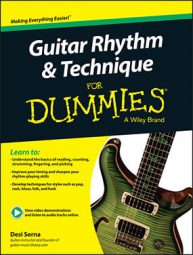In order to bend strings on a guitar, you need to use a light gauge of strings. String gauge refers to the thickness of the guitar string — the larger the gauge, the heavier the string. Thickness is measured in thousandths of an inch, and string sets are categorized by the gauge of the first string specifically.
Typically, electric guitars are strung with a set of strings that include a first string measuring 0.009, or a set of “9s” as guitarists usually say. Strings this size or lighter are fairly easy to bend. String gauges heavier than this are harder to bend and require a well-conditioned hand with extra-thick calluses.
Because acoustic guitars are designed to produce a maximum amount of acoustic volume, as opposed to an electric, which benefits from magnetic pickups and amplification, they’re strung with heavier-gauge strings. These strings may produce a better acoustic tone, but they’re very hard, sometimes impossible, to bend. As you work through bending, use a guitar strung with light-gauge strings, like an electric, or restring an acoustic with extra-light strings, being sure to not use a wound third string.
Something else to take into consideration as you work with bends is the strength of your fingers and the thickness of your calluses. Bending puts tremendous pressure on your fingertips, taxing your hand well beyond what ordinary playing does. Your fingers will get sore as you practice bending. As you strengthen your muscles and thicken your calluses, bending will become easier and feel more comfortable.
One final point to make, it’s fairly common in rock music for guitarists to tune all of their strings down by a half-step. This lowers the sixth string, E, to E♭ (hence, the name E♭tuning). This tuning’s popularity is based on a few things:
Some players find the slightly lower tonality to be preferential.
Singers are better able to hit the high notes.
Lowering the tuning loosens the strings and makes bending easier!
E♭ó tuning is used on Jimi Hendrix’s “Voodoo Child (Slight Return),” Guns N’ Roses’ “Sweet Child O’ Mine,” and Stevie Ray Vaughan’s “Pride and Joy” just to name a few.

